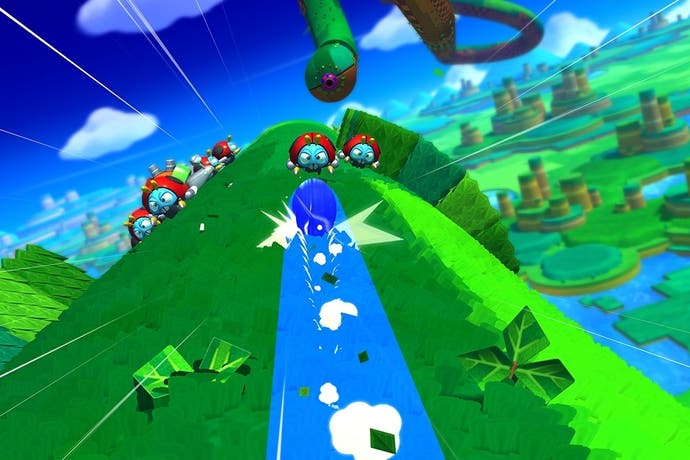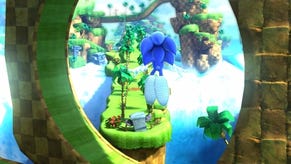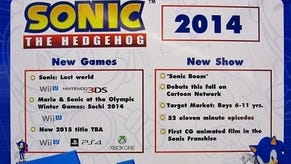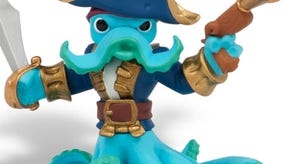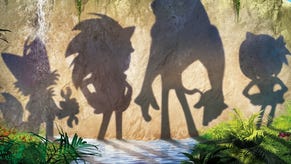Sonic Lost World review
'Hog roast.
You could cut a heck of a trailer from Sonic Lost World. Slice its levels up into two-to-five-second snippets and you'd find dozens of moments of visual magic. OPEN ON: Sonic arcing around a loop at full tilt. CUT TO: Sonic skipping past enemies, spinning and somersaulting over mechanical ladybugs before punting them into the ether. CUT TO: Sonic skidding across grind rails out of the screen, sprinting across walls, pinging between bumpers like a spiky pinball, leaping and bouncing as the world rotates around him. CGI close-up, witty one-liner, title splash, done!
In fact, the game's highlights look so terrific that the frustration of playing the damn thing is even more acute. The trouble with each and every one of those moments is that they're spread very thinly - fleeting, fizzy bursts of joy found in levels more bloated and inconsistent than a Gore Verbinski film.
Worse still, the best bits often come when control is taken away from you, either partially or entirely: the moments when a boost pad prompts a brief cutaway as Sonic pulls off a spectacular move, or when you're merely called upon to press the jump button a few times as the 'hog hops across several enemies to clear large gaps, or accelerates down a ramp as you let go of the analogue stick and simply let momentum take its course. Sonic Lost World is at its best when player involvement is at a minimum.
When it's not playing itself, however, this game can be profoundly frustrating. Many have observed from early footage that Sonic Team has taken a few cues from Super Mario Galaxy. Not such a terrible idea, you might think, but the developer doesn't have Nintendo EAD Tokyo's understanding of how its protagonist fits into its world. A great Mario level sees its hero become the final cog in a well-oiled machine; by contrast, Sonic feels like a slightly misshapen part of some self-assembly furniture, never quite slotting into place - at least not without some effort on your part.
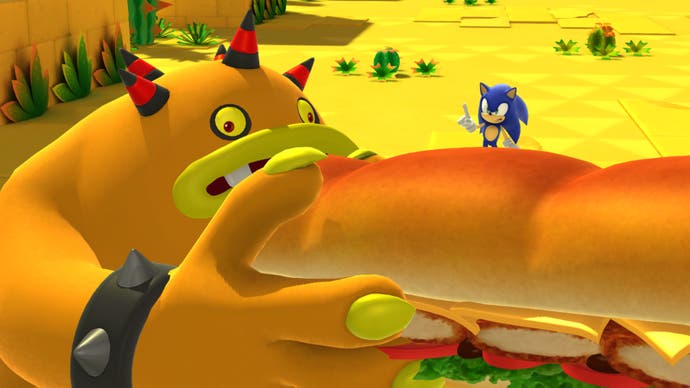
The biggest problem is the way Sonic handles. Most would agree that Sonic Team got it right first (and second, and third) time and have been struggling to recapture that blend of pace and manoeuvrability ever since. And yet I honestly can't think of another occasion when Sonic has felt so wrong.
As the levels here are both more intricate and expansive than usual, the game allows Sonic to move at two speeds, modified with the right trigger. But neither feels right: Sonic's too sluggish while walking, and too skittish to cope with the trickier platforming bits when running. The idea, presumably, is to switch when greater precision is required, except that slowing down reduces your jump distance to an infuriating degree. You'll jam the analogue stick upwards so hard it's in danger of breaking free from its moorings, and yet you'll spin hopelessly into the void time and again.
Occasionally, the camera's to blame, jerking sideways as you attempt lateral movement, or shifting position in mid-air to make landing all the trickier. It's baffling that Sonic Team should get fundamentals like this so wrong.
It hardly helps that locking onto enemies is so imprecise. Most of the time it works perfectly well: you jab the jump button, a targeting reticle appears on the nearest enemy, you press again to attack. You can string attacks together to take out multiple enemies, liberating fluffy animals from their mechanical prisons in the great Sonic tradition. And yet...
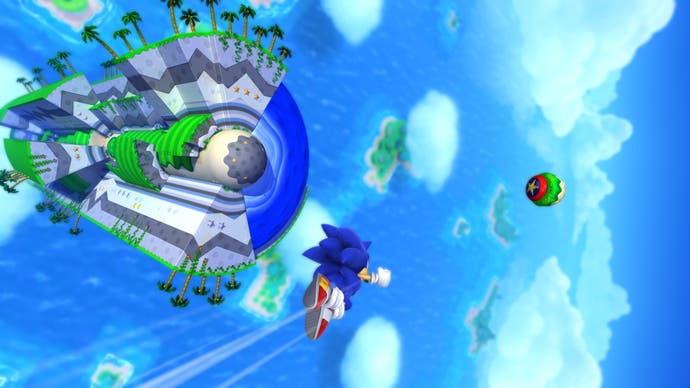
Sometimes, when you need to hit several enemies in a row to get across a large gap, you'll hit the first two, Sonic will inexplicably fail to connect with the third and you'll fall to your death. Sometimes you'll jump towards an enemy and Sonic will opt instead to perform a simple double-jump and take damage as he collides with his intended target. Sometimes the reticle will automatically target an enemy that damages you when you try to attack. Sometimes it does that when you're in the air and the camera helpfully assumes a position that prevents you from seeing what you're about to land on. Sometimes you will want to shout and swear and throw things.
It hardly helps that the enemies can be unbearably cheap. Like an invisible chameleon that suddenly appears on the wall you were climbing. Or a crab that fires its shell upwards when you try to jump over it. Or a burrowing enemy that pops up directly underneath you when you're running an already spike-infested gauntlet. Or a scurrying critter that emerges from a bush without any kind of prior warning of their presence. Enemies don't show up to challenge you, merely to annoy you. They'll bring you to a grinding halt when you need momentum to clear a gap, patrol tiny platforms you need to leap to, bounce you off into the void when you land on or near them.
Imagine all of those things, and now imagine them all in a slippy-slidey ice world that makes Sonic even harder to control, and you might understand why I came perilously close to biting my GamePad at one particularly sharp difficulty spike. Dying at the same section of a level prompts the appearance of a wing power-up that allows you to skip to the next checkpoint, which seems less like a helping hand and more like a silent understanding that no sane person could possibly want to repeat that part of the game.
All the while, Sonic Lost World attempts to ape Mario Galaxy's perspective shifts, but in an oddly awkward way - moving the viewpoint simply because it's possible, rather than to serve the design of the stages. You won't find a more restless camera this side of a Platinum Games title, but such hyperactivity often gives you little more than a headache. When you land on solid ground, you'll frequently have to pause for a second just to get your bearings.
Sonic Team throws everything it can at the game in the hope that something will stick. Yet the result is a disastrous lack of focus
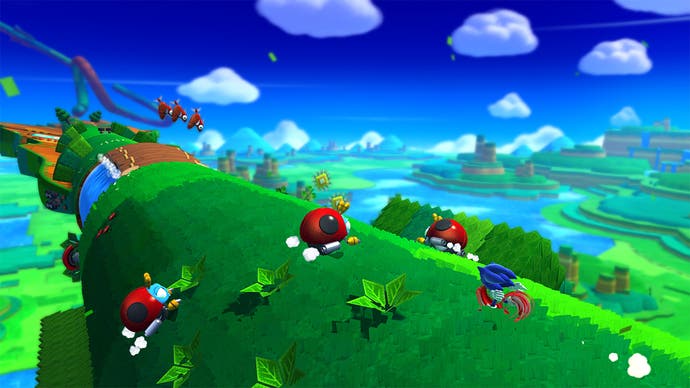
The most heartbreaking thing about all this is that Sonic Team is clearly trying; the developer throws everything it can at the game in the hope that something will stick. Yet the result is a disastrous lack of focus. You're encouraged to hurry through levels, yet by doing so you're missing out on the animals you'll need to free to unlock later levels, or the collectable emblems that unlock secret stages and mini-games.
The powers from Sonic Colours return, yet many of them lead to clumsy touchscreen or gyro interludes that kill a level's pacing. And while Sonic's newfound parkour skills allow him to run along and up walls, if you've not got sufficient momentum to hit the top - or if you've accidentally climbed a wall you couldn't sidestep because Sonic can't turn well at top speed - you'll face an agonising wait for him to slowly slide back down.
It's telling that the highlights of Lost World are the moments where Sonic Team allows the hedgehog to do what he does best: high-velocity platforming that tests your ability to follow high-speed action and to reflexively respond to danger. Sonic thrives on simplicity, and I still think Sega could reinvent him for the mobile market: give PastaGames a call, perhaps, and get them to make a side-scroller along the lines of Rayman Jungle Run rather than the aggressively monetised Sonic Dash. There are fleeting signs here that such an approach could work. Yet these brief flickers of life are few and far between, buried within a flabby, disjointed mess of a game.
